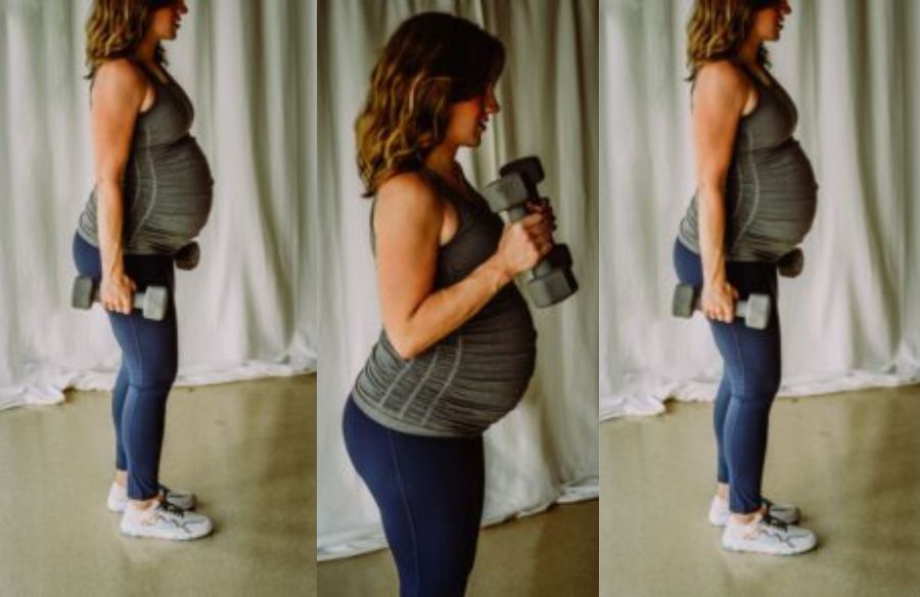We test and review fitness products based on an independent, multi-point methodology. If you use our links to purchase something, we may earn a commission. Read our disclosures.
Misinformation on the internet is about as rampant as wildfires in California, and women’s health topics are no exception. Archaic beliefs about pregnancy are unfortunately still prevalent today—you’re eating for two, you need to give up caffeine, or you shouldn’t travel are just a few. Exercise during pregnancy is another, but lucky for you, I’m here to thoroughly debunk this one.
If you’re looking for an answer to the question, “Can you lift weights while pregnant?” you came to the right spot. The TL;DR is: Pregnant women are capable of much more than we give them credit for! I’ve seen pregnant moms carrying a 25-pound toddler on one hip and five grocery bags in the other hand without a second thought.
And as a mom of two, certified personal trainer, and prenatal fitness coach myself, I know from firsthand experience that lifting weights while growing a baby can be one of the best things you can do. I’m breaking down everything about pregnancy and lifting weights below.
Is Lifting Weights While Pregnant Safe?
Let’s cut to the chase—for women with healthy pregnancies, not only is lifting weights while pregnant OK, it can actually be super beneficial for mom and baby.
“Pregnancy is not a medical condition,” says Rachel MacPherson, ACE-certified personal trainer, Girls Gone Strong-certified prenatal/postpartum coach, Girls Gone Strong-certified women’s coaching specialist. “It’s a phase of life that requires strength, endurance, and physical exertion both during gestation, and afterwards in delivery and recovery. It’s highly beneficial for women to keep strong and fit during pregnancy by lifting weights unless their doctor has told them otherwise.”
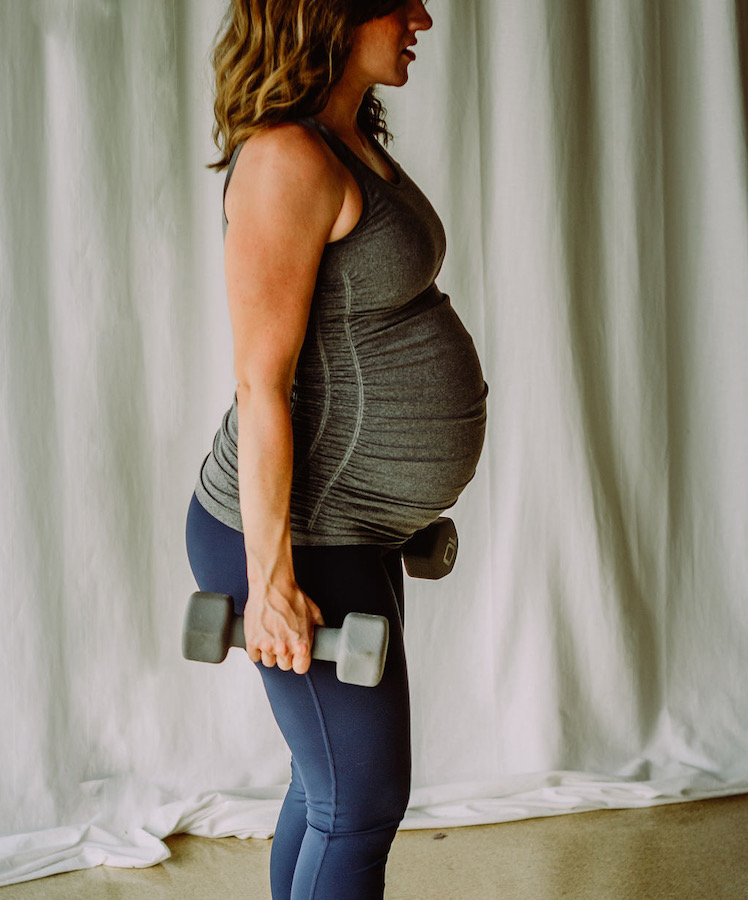
And that last point is important—if your doctor has advised you against weight training or any notable physical activity, you should listen for the safety of you and your baby. However, if your doctor gave you the green light to lift weights, read on for our tips.
Benefits of Lifting Weights While Pregnant
Pregnancy is both beautiful and challenging, and developing a consistent exercise routine can help you navigate the months feeling a little more in control.
The American College of Obstetricians and Gynecologists (ACOG) recommends pregnant women get 150 minutes of moderate-intensity aerobic exercise every week, but does not make a recommendation about strength training. That being said, even a few short sessions of strength training a week with resistance bands, dumbbells, a barbell, or other free weights can:
Decrease Pregnancy Complications
Women who are active before and during pregnancy tend to have less incidence1 of conditions like gestational diabetes, high blood pressure, and pre-eclampsia, which can be threatening to the health of both mother and baby.
Mitigate Aches and Pains
Between the hormone relaxin that is responsible for increasing laxity in your joints and ligaments to support your changing body, to a growing bump that changes your center of gravity, pregnancy can cause lower back pain, pelvic pain, and more. “Staying strong and stable during pregnancy can ward off many of these adverse effects,” Rachel explains.
Help Increase Energy Levels
A study in the Journal of Psychosomatic Obstetrics & Gynecology2 found that low-to-moderate intensity weight training during pregnancy decreased perceived physical and mental fatigue among 26 women in their second and third trimesters.
Support Healthy Weight Gain
ACOG recommends3 that women of healthy weight gain between 25 and 35 pounds during the course of pregnancy, while those who are overweight should only gain between 15 and 25 pounds and those who are underweight should gain between 28 and 40 pounds. These numbers are guidelines, and some women gain more weight even with a healthy lifestyle while pregnant. In general, given healthy habits, your body will gain what it needs, so always talk to your doctor about concerns surrounding prenatal weight gain.
That being said, several studies have demonstrated that resistance training during pregnancy helped mitigate excess weight gain, including a 2009 study in the International Journal of Obesity4 and an older 1995 study from Medicine & Science in Sports & Exercise5. One healthy habit can steam roll into another, so getting into the routine of strength training will only make eating a healthy and balanced diet more likely.
Support Better Body Image
From the hormonal changes to the weight gain, many women don’t feel great about themselves during pregnancy. An interesting study published in Medicine & Science in Sports & Exercise6 found that women who exercised during pregnancy had a much better self-reported body image than those who were sedentary.
Make For An Easier Labor & Delivery
According to the same Current Sports Medicine Reports1 study mentioned earlier, women who remain physically active during pregnancy and maintain a base of strength tend to have less incidence of induction and c-section, plus have decreased time in labor—including being twice as likely to progress from 4 to 10 centimeters in less than four hours and decreased time in the second stage of labor from an average of 60 to 36 minutes. They also tend to have decreased recovery time postpartum.
Benefit Baby
A study published back in 2000 in the American Journal of Obstetrics and Gynecology7 found that babies born to women who completed three to five strength training sessions per week were longer and had more lean body mass than the control group.
Things to Watch Out For
The most important rule of thumb when lifting weights while pregnant is to listen to your body. If you’ve never strength trained before, take things slow and steady and save the heavy weights for after the baby is born. And even if you’re no stranger to the gym, now is not the time to try and PR your bench press or squat.
Use RPE
Monitor your exertion using the talk test, as recommended by ACOG, to ensure you’re working at a level appropriate for you and your fitness level. A good rule of thumb is to stay at an RPE of 4 to 5 on a 10 RPE scale, which is moderate intensity. Also, if you feel like you’re overheating, you probably are, so find a spot to cool down.
Take Care On Your Back
In addition, laying in a supine position should be approached with care in the second trimester and third trimester. The major vein that carries blood from your lower back to your heart, called the vena cava, can be compressed in this position and restrict blood flow, especially as the baby grows. If you’ve had a healthy pregnancy, keep time on your back at a minimum. Those with high-risk or complicated pregnancies should consult their OB-GYN before performing any exercises on their backs at all.
Modify Plyometrics
Plyometrics are another type of strength exercise to approach with caution, because of the intensity and the increased chance of falling. ACOG recommends avoiding any activities that may result in falling or injury to the abdomen, and exercises like box jumps or broad jumps could certainly fall in this category. Modify moves like this to eliminate jumping just to be extra safe.
Choose Pregnancy-Safe Ab Exercises
And lastly, also take care with abdominal exercises during later stages of pregnancy. As the baby grows, your abdominal muscles stretch to make space. Called diastasis recti, this condition is very common, but exercises that put additional strain on the six-pack muscles can exacerbate it, which is something we don’t want. Avoid exercises9 like sit-ups and crunches after the first trimester of pregnancy to help prevent it.
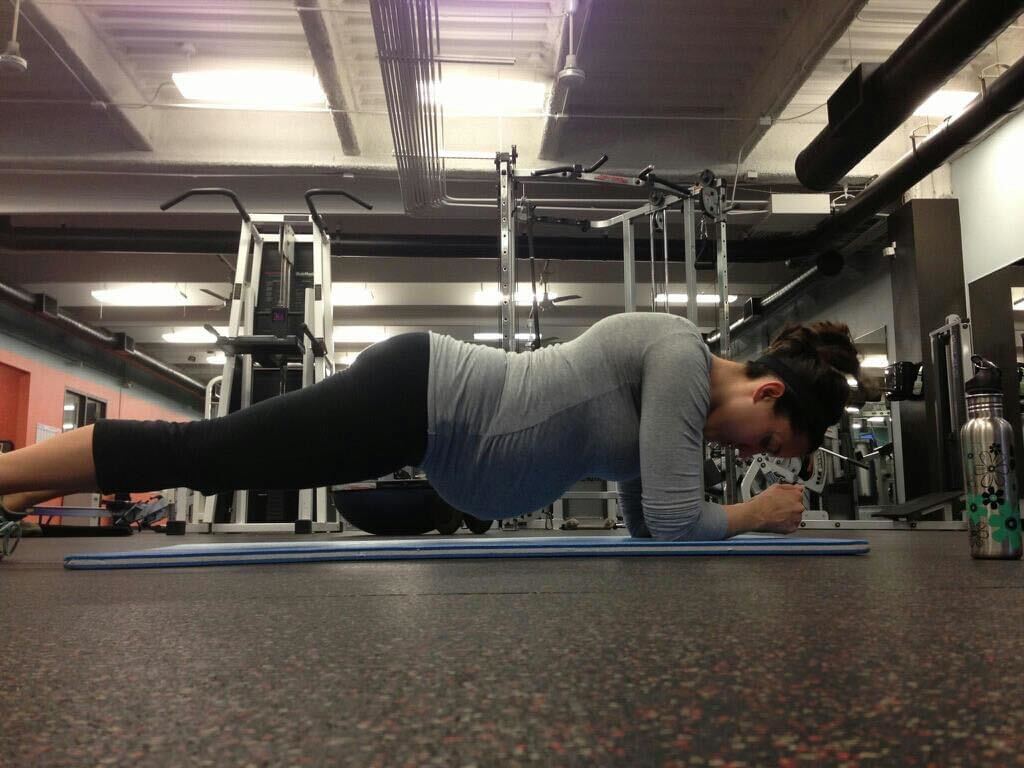
Warning Signs
According to ACOG, if you experience any of the following symptoms while exercising, stop and contact your healthcare provider.
- Vaginal bleeding
- Fluid leaking from the vagina
- Regular, painful contractions
- Feeling dizzy
- Shortness of breath before starting exercise
- Chest pain
- Headache
- Muscle weakness
- Calf pain or swelling
Exercises to Do While Pregnant
A pregnancy workout doesn’t have to look that much different than a non-pregnancy workout—you may be moving a little slower and you’ll have to make a few adjustments like choosing lighter weights, but don’t let pregnancy stop you from lifting weights.
In general, you won’t have to make any modifications to strength training moves in the first trimester—that is, if you have the energy to even make it to a workout between morning sickness and extreme exhaustion! In the second and third trimesters you’ll have to accommodate your growing bump.
While a full-body workout routine will serve you best, muscle groups that will take a beating during pregnancy and the postpartum period include your abdominal muscles, pelvic floor, and upper back muscles, so it’s ideal to incorporate exercises that will strengthen these areas.
Rachel shared her favorite strength exercises for pregnancy with us here, including:
Pallof Press
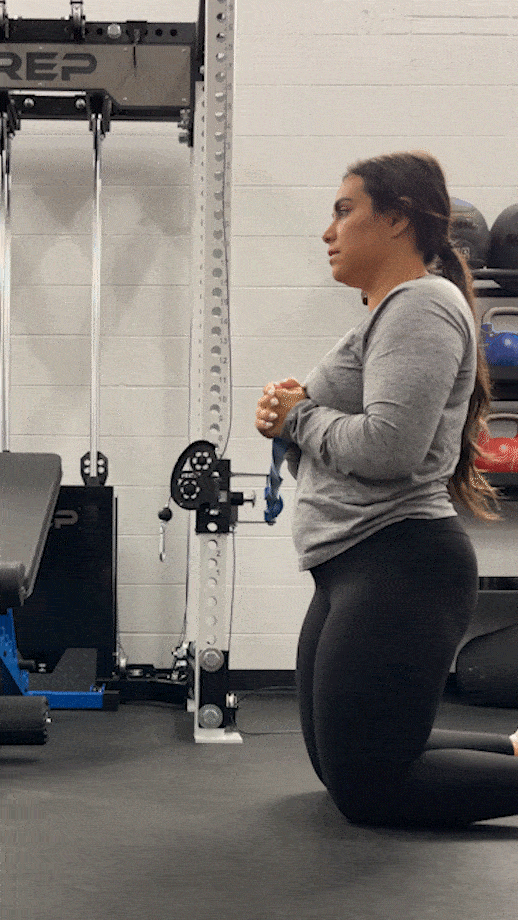
Split Squats
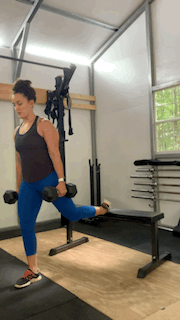
Goblet Squats
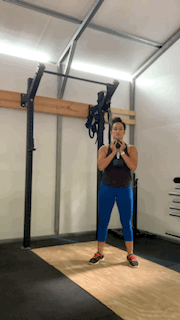
Glute Bridge
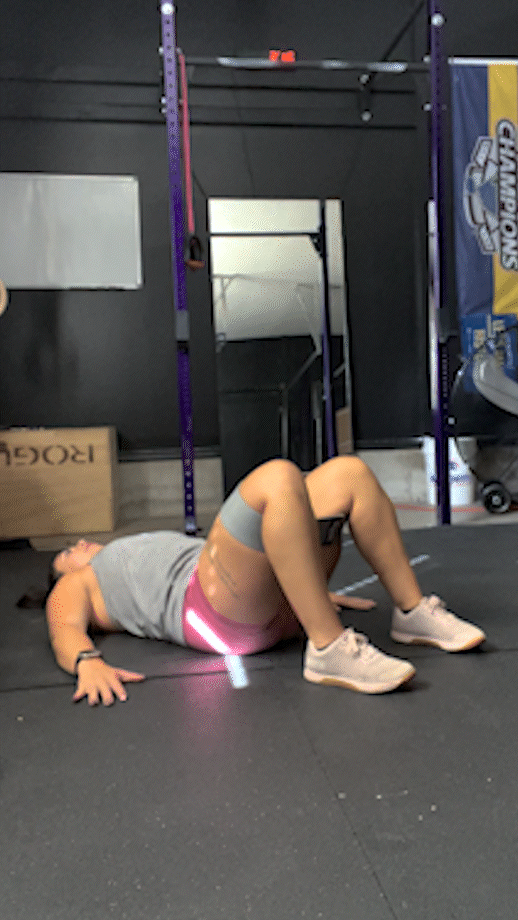
Deadlifts
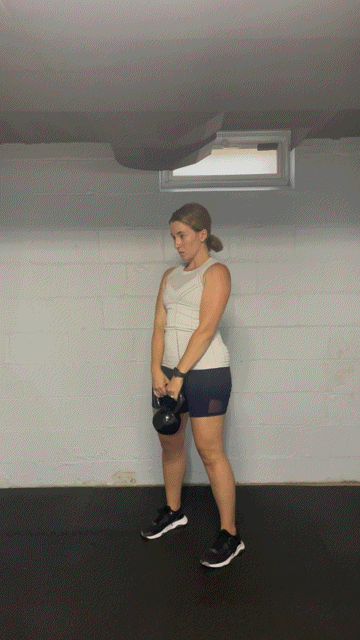
Bent Over Rows
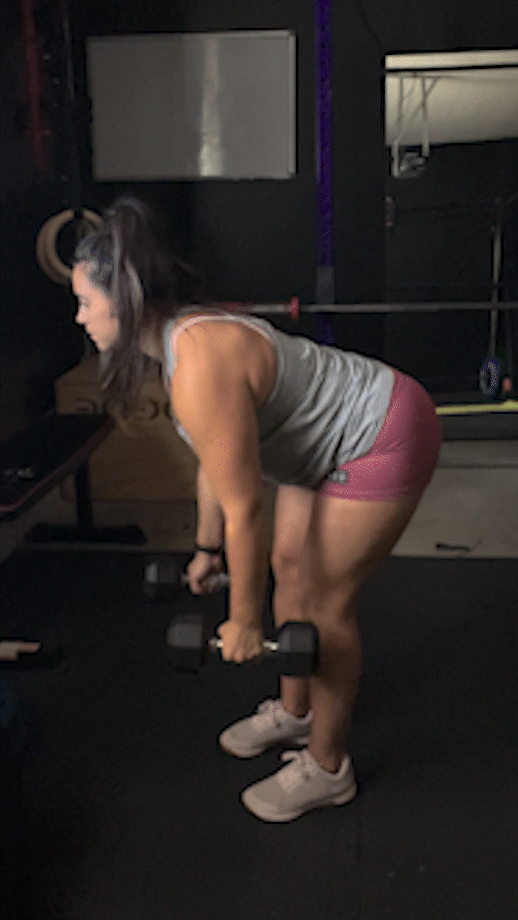
Clamshells
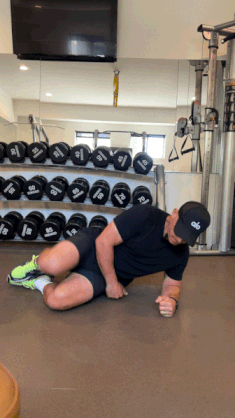
Band Pull-Aparts
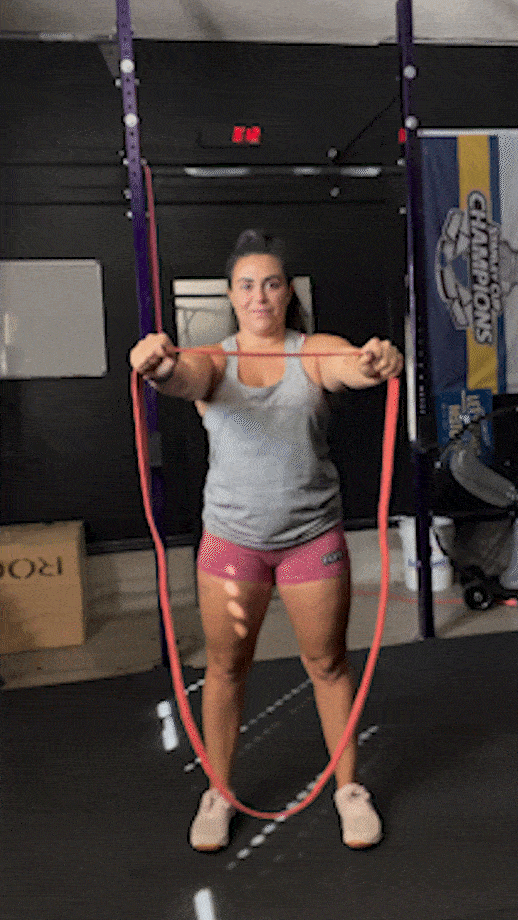
Lat Pull-Downs
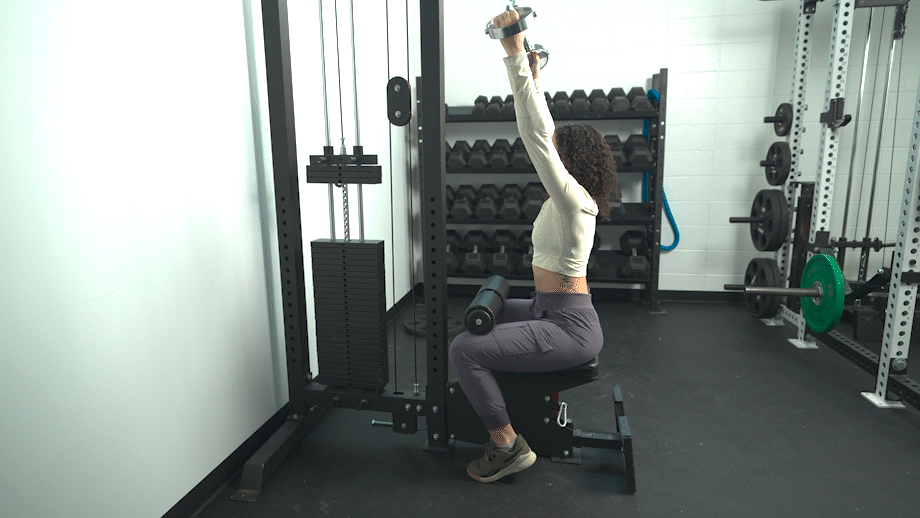
If you feel like you need extra guidance, Rachel recommends consulting a prenatal fitness specialist or other quality resources like the Girls Gone Strong free prenatal strength training course or their prenatal training bundles.
How Much Weight Should I Lift While Pregnant?
If you’re committed to lifting weights during pregnancy but aren’t sure how much is too much, I always recommend listening to your body. Someone who is very conditioned and has been heavy lifting for years will have a higher threshold while pregnant than someone who is brand new to exercise.
In general during prenatal exercise, you’ll want to remain at a 4 to 5 RPE on a 10 RPE scale. This is considered moderate intensity where you can still pass the “talk test,” but are breathing heavily. Keep this in mind when selecting your weights.
For strength training, an RPE of 4 to 5 would be well suited for lighter weights and higher reps—think three sets of 10 to 15 repetitions. You’ll want those 10 to 15 reps to be a challenge, but you should easily be able to complete the set without a ton of effort.
Can You Lift Weights While Pregnant? Final Thoughts
Lifting weights while pregnant can provide many benefits during gestation and into the postpartum period for both you and your baby:
- Women who consistently weight train during pregnancy tend to have fewer complications, better body image, easier labors, and healthy babies.
- You can perform many of the same exercises pregnant as you would otherwise; just take care with certain moves like ab exercises, exercises on your back, and plyometrics.
- Always consult your OB-GYN before lifting weights while pregnant, and listen to your body while you’re exercising—if you feel any type of pain or discomfort, stop out of caution.
Can You Lift Weights While Pregnant?: Q&A
How much weight can you lift when pregnant?
This is totally dependent on the person and their fitness level pre-pregnancy. Athletes or very conditioned individuals will be able to lift more than those who recreationally lift or are new altogether. Proper form is key, and evaluate your effort based on an RPE scale, sticking to moderate-intensity exercise.
What happens if you lift weights while pregnant?
Great things can happen! Not only is it great for mom to lift weights for pregnancy exercise to maintain a strong physique that can withstand the rigors of pregnancy and delivery, it can be beneficial for baby, too. Numerous studies have shown that a consistent strength training routine can help decrease pregnancy complications like the risk of gestational diabetes, make for shorter labors, and even birth babies who have more lean body mass.
When should I stop lifting while pregnant?
Always consult your doctor about lifting weights while pregnant, but in general, if you’ve had a healthy pregnancy and it’s comfortable for you to lift light weights up until your due date, go mama! It’s all about listening to your body, though. If strength training becomes too taxing, especially toward the end of pregnancy, choose movement that feels good to you instead. If you have any pregnancy complications, don’t lift weights until you speak with your doctor.
Can you lift 5-pound weights when pregnant?
If you’ve had a healthy pregnancy, yes, lifting five pounds should be no issue. If you have any complications, consult your doctor before lifting anything.
References
- Albright, Elizabeth DO, PGY-2. Exercise During Pregnancy. Current Sports Medicine Reports 15(4):p 226-227, 7/8 2016. | DOI: 10.1249/JSR.0000000000000277
- Ward-Ritacco C, Poudevigne MS, O’Connor PJ. Muscle strengthening exercises during pregnancy are associated with increased energy and reduced fatigue. J Psychosom Obstet Gynaecol. 2016;37(2):68-72. doi: 10.3109/0167482X.2016.1155552. PMID: 26984583; PMCID: PMC4978349.
- Weight gain during pregnancy. ACOG. Jan 2013.
- Barakat R, Lucia A, Ruiz JR. Resistance exercise training during pregnancy and newborn’s birth size: a randomised controlled trial. Int J Obes (Lond). 2009 Sep;33(9):1048-57. doi: 10.1038/ijo.2009.150. Epub 2009 Jul 28. PMID: 19636320.
- Clapp JF 3rd, Little KD. Effect of recreational exercise on pregnancy weight gain and subcutaneous fat deposition. Med Sci Sports Exerc. 1995 Feb;27(2):170-7. PMID: 7723638.
- MARQUEZ-STERLING, SYLVIA; PERRY, ARLETTE C.; KAPLAN, TED A.; HALBERSTEIN, ROBERT A.; SIGNORILE, JOSEPH F.. Physical and psychological changes with vigorous exercise in sedentary primigravidae. Medicine & Science in Sports & Exercise 32(1):p 58, January 2000.
- Clapp, J. F. , Kim, H. , Burciu, B. & Lopez, B. (2000). Beginning regular exercise in early pregnancy: Effect on fetoplacental growth. American Journal of Obstetrics and Gynecology, 183 (6), 1484-1488.
- Exercise during pregnancy. ACOG.
- Diastasis Recti. Cleveland Clinic. February 2022.
Further reading

Does the best ratio for BCAAs exist? Research suggests so, and GGR’s nutrition experts reveal all you need to know to maximize your health and fitness! Read more

Looking for some excellent fitness gifts for mom? We have great ideas from high-tech to low-cost presents. Read more

Ready for a fun, low-impact cardio workout? Our expert breaks down the 10 best water aerobics exercises so you can use a swimming pool to get in shape. Read more

What muscles does cycling work? Our in-depth guide takes an expert look from CPTs at which body parts get activated while riding an exercise bike. Read more

